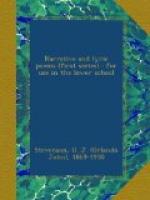[13] Parthemus. A mountain range in Greece.
[14] Cirrha’s dome. The dome of the temple of Apollo at Delphi, near Cirrha, in Greece.
[15] Adria. The Adriatic.
[16] Lacedaemon. Sparta, which was governed by two kings representing two great families.
[17] Porcian height. Monte Porzio, near the scene of the battle.
[18] Corne. A hill near Tusculum.
[19] Fair Fount. A spring in the vicinity.
[20] Thirty Cities. The Latin cities, banded together in aid of the Tarquins.
[21]"One spot on the margin of Lake Regillus was regarded during many ages with superstitious awe. A mark, resembling in shape a horse’s hoof, was discernible in the volcanic rock; and this mark was believed to have been made by one of the celestial chargers.”—Macaulay.
[22] a Virginius. One of the family of the Virginii.
[23] The consul who was elected first was usually held in greater honour than the other.
[24] Gabii. A Latin city about twelve miles from Rome.
[25] Conscript Fathers. The senate. The original expression is patres conscripti (patres et conscripti), patres referring to the patrician element, and conscripti to the plebeian element in the senate.
[26] Camerium. One of the Latin cities.
[27] Master of the Knights. Chief lieutenant.
[28] The Consuls usually had twelve lictors each; the Dictator twenty-four.
[29] Witch’s Fortress. The town of Circeii, which Macaulay associates here with Circe, the enchantress.
[30] ghastly priest. The temple of Diana, in a grove near Aricia, had for its priest a runaway slave, who was to hold office until slain by another runaway slave stronger than he.
[31] Ufens. A river.
[32] Laurentian jungle. Marshy thickets near the town of Laurentum.
[33] Carthage. On the north coast of Africa. The Carthaginians were a commercial and sea-faring people.
[34] a woman. Lucretia. After she had been wronged by Sextus, she stabbed herself and died.
[35] Tibur. The modern city of Tivoli.
[36] Soracte. A snow-capped mountain about twenty-five miles from Rome.
[37] Apulian. Apulia was one of the divisions of Italy.
[38] targe. shield.
[39] Pomptine. The Pontine marshes in the southern part of Latium.
[40] Digentian rock. A crag near the river Digentia.
[41] Bandusia. A fountain.
[42] Auster. The word signifies “the stormy south wind.”
[43] crown. The first Roman to scale the walls of a besieged town received a crown of gold.
[44] Calabrian. Calabria forms the “heel” of Italy.
[45] Pruning the vines entwined around the trunks of the elms.
[46] clients. Servants attached to the Patrician families.




